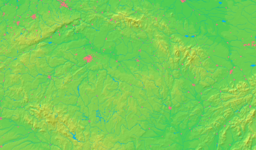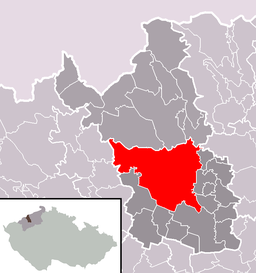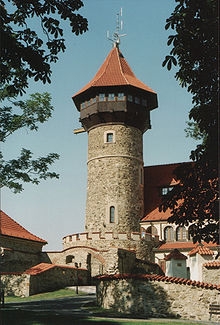- Most
-
For other uses, see Most (disambiguation).
Most City FlagCoat of armsName origin: bridge Country Czech Republic Region Ústí nad Labem District Most River Bílina Elevation 233 m (764 ft) Coordinates 50°30′11″N 13°38′12″E / 50.50306°N 13.63667°E Area 86.94 km2 (34 sq mi) Population 67,189 (June 2009[update]) Density 773 / km2 (2,002 / sq mi) First documented 10th century Mayor Vlastimil Vozka Timezone CET (UTC+1) - summer (DST) CEST (UTC+2) Postal code 434 01 Location in Most DistrictWikimedia Commons: Most Website: The City of Most Most (Czech pronunciation: [ˈmost]; German: Brüx) is the capital city of the Most District, situated between the Czech Central Mountains and the Ore Mountains, approximately 77 km (48 mi) northwest of Prague along the Bílina River and southwest of Ústí nad Labem.
Contents
Etymology
The name Most means "bridge" in Czech. The town was named after the system of bridges over swamps which lay in this area in 10th century. The German name for Most is Brüx (derived from the German word for "bridge", Brücke).
History
The Latin Chronica Boemorum mentions a Slavic settlement below the Gnevin Castle called Gnevin Pons (Czech: Hněvínský most) in 1040. Through the swamps there led a merchant route from Prague to Freiberg. The network of wooden bridges was built to provide comfortable passages through this territory. Hneva from the Hrabisic dynasty established a military stronghold to protect caravans. Under this stronghold the village that would become Most developed.
In 1227 Kojata, the last of the Hrabisics, passed his property to the cloister of the Knights of the Cross. Since 1238 the royal town was owned by the Přemyslids and it became a rich city with many churches. The Bohemian kings Otakar II, John of Luxembourg, and Charles IV all granted Most city rights. In the 14th century, due to colonization, the city became predominantly German-populated and known as Brüx.
During the 15th and 16th centuries the city was hit by several fires. Ca. 1517, city reconstruction began the foundations of several significant facilities, including the new dean's church and the Renaissance city hall.
During the Thirty Years' War, the city was occupied by Swedish troops. Both in the early years and in the last years of the war it was captured by stratagem. In a similar manner the castle Hněvín was captured. After the Thirty Years' War, the city lost much of its economical and political significance.
In the second half of the 19th century industry and mining emerged, and in 1870, a railway line was built. Construction included sugar works, porcelain factory, steel works, brewery, and the founding of city museum. In 1895 the city was affected by quicksand that swallowed several houses, including some of their occupants. In 1900 the RICO plant for dressing material was constructed. In 1901, an electric street car line linked Brüx with Kopitz up to Johnsdorf. The most modern theatre of its time within Austria-Hungary was opened in Brüx in 1911. The construction of a unique dam at Kreuzweg from 1911 to 1914 solved the city's problem with the supply of drinking water.
On December 15, 1942, Brüx began output of Ersatz fuel synthesized from brown coal at the Sudetenländische Treibstoffwerke AG (STW) Maltheuren plant,[1][2] and a subcamp of Sachsenhausen provided forced labor. Stalag IV-C (Wistritz bei Teplitz) was at the "Sudentenland Treibstoff Werke",[3] and Brüx was repeatedly bombed during the Oil Campaign of World War II. Post-War, Most was restored to Czechoslovakia and, following the expulsion of Germans after World War II (mainly 1946), Czechs replaced the Germans.
After 1964 the process of "moving" the city began. During the 1960s, Most's historic centre was completely destroyed to make room for the expanding lignite mines, a process that lasted until 1970. This process involved the destruction of many historic monuments, including a brewery dating from the 15th century and a theatre designed in 1910 by Alexander Graf, a Viennese architect who designed many theatres across Central Europe, including ones in Ostrau and Laibach. One building, however, was preserved: the Gothic Church of the Assumption of the Virgin Mary, built between 1517 and 1594 and designed by Jakob Heilmann of Schweinfurt. In 28 days it was moved by train to the new town, 841 metres away, at the rate of roughly 30 metres per day. This building was mentioned in the Guinness Book of World Records as the heaviest building ever moved on wheels.
Most nations Early Hrabisic dynasty 1238 Přemyslid dynasty ? Kingdom of Bohemia 1526 Habsburg Monarchy 1806 Austrian Empire 1866 Austro-Hungarian Empire post–World War I Czechoslovakia 1938 Nazi Germany 1945 Czechoslovakia 1993 Czech Republic Life in the town
As a redeveloped city Most does not have many historical sights, yet there are two important ones: Hněvín Castle and the Gothic Church of the Assumption of the Virgin Mary. On the other hand there are many amusement facilities which can be visited: planetarium, observatory, autodrome, aquadrome or hippodrome.
Most is known for its huge share of people living in panelaks. The decimated environment along with urban development has given the outskirts of the city a depressing feeling. Things are changing and in 2007 a number of new developments were planned and are now under construction in the centre of the City. Of note are some small residential housing projects along with a major new shopping centre right in the centre. On the other side the concentration of population in the flats enabled remarkable development of informational technologies. For example the cable television project functional in 1988 was something unusual in any other Czech city. Now many people have access to the broadband internet at prices well below average in the Czech Republic.[citation needed]
The new city is well-designed (wide streets, many parks in the center), especially the infrastructure and traffic situation is quite good in comparison with cities of similar size. The social situation of local people is bad. With the unemployment rate of nearly 25% (as of 2005) the locality is far the worst in the Czech Republic. This number is caused by huge workforce of aging unqualified miners. Also flat accommodation is quite cheap so it pushes more unemployed people from other regions to live there and raises this number.[citation needed] More recently, unemployment has been falling and government sources put the figure at around 15% in 2007.
Due to heavy social and European Union funding and the development of local business and industry, Most is beginning to recover.[citation needed]
The Hippodromo (Racecourse) in the Velebudice district of Most was the host of the 18th International Meeting of 2CV Friends between 28 July and 2 August 2009, attracting 3,333 vehicles and approximately 10,000 people.
Industry
Most is the heart of the northern Bohemian lignite-mining region and serves as an important industrial railway junction. Other industries in Most include textile, ceramics, steel, and chemicals.
During the second half of the 20th century Most turned into a dusty and dirty miner town and in the communist era it was said to be one of the darkest cities of Czechoslovakia.
The mining itself has a long tradition in the area. Extensive mining operations continued after the year 2000, but are completely under control of foreign companies. Many surrounding villages are planned to be abandoned due to surface mining.[citation needed]
Unsurprisingly, heavy industry has shaped the image and development of post–World War II Most.
As environmental conditions have improved in recent years, the growing of apples and grape vines has developed.
City districts
- The neighborhood of Rudolice nad Bílinou is home to a housing estate known as Chánov, created during the communist era, which has become a symbol of the poverty and ghettoization of many Roma people in the Czech Republic.
- Vtelno used to be a village near Most. When the new city was built near it, Vtelno became an integral part of Most. It has a church, a historical Baroque manor, and many monoliths and sculptures that have been collected during the era of demolition of villages in the region (due to coal mining).
People
- Andreas Hammerschmidt (ca. 1611–1675), composer
- Florian Leopold Gassmann (1729–1774), composer
- Wenzel Hablik (1881–1934), painter and architect
- Judita Čeřovská (1929–2001), singer
- Josef Masopust (born 1931), football player and coach
- Jan Mühlstein (born 1949), politician
- Pavel Chaloupka (born 1959), football player
- Vladimír Růžička (born 1963), ice hockey player
- Libor Pimek (born 1963), tennis player
- Petr Svoboda (born 1966), ice hockey player
- Martin Ručínský (born 1971), ice hockey player
- Jan Vopat (born 1973), ice hockey player
- Petr Franěk (born 1975), ice hockey player
- Vlastimil Kroupa (born 1975), ice hockey player
- Petr Johana (born 1976), football player
- Jan Zajac, (born 1980), boxer
- Marek Židlický (born 1977), ice hockey player
- Pavel Rosa (born 1977), ice hockey player
- Kamil Piroš (born 1978), ice hockey player
- Tomáš Divíšek (born 1979), ice hockey player
- Markéta Jánská (born 1981), model
- Tomáš Kůrka (born 1981), ice hockey player
- Iveta Benešová (born 1983), tennis player
- Lukáš Kašpar (born 1985), ice hockey player
- Brad Burton (born 1976), pornstar
Neighboring cities and towns
Litvínov, Chomutov, Žatec, Louny, Teplice, Kadaň
International relations
See also: List of twin towns and sister cities in the Czech RepublicTwin towns — Sister cities
Most is twinned with:
 Meppel, Netherlands
Meppel, Netherlands Marienberg, Germany
Marienberg, Germany Ptolemaida, Greece
Ptolemaida, Greece Gävle, Sweden
Gävle, Sweden Kortrijk, Belgium
Kortrijk, Belgium Thunder Bay, Canada
Thunder Bay, Canada Ekaterinburg, Russia
Ekaterinburg, Russia Ulaanbaatar, Mongolia
Ulaanbaatar, Mongolia São Paulo, Brazil
São Paulo, Brazil Lahti, Finland
Lahti, Finland Bucharest, Romania
Bucharest, Romania Venice, Italy
Venice, Italy Shanghai, China
Shanghai, China Osaka, Japan
Osaka, Japan Buenos Aires, Argentina
Buenos Aires, Argentina Brisbane, Australia
Brisbane, Australia Kulon Progo, Indonesia
Kulon Progo, Indonesia
References
- ^ "tbd". chemopetrol.cz. http://www.chemopetrol.cz/html/index.php?s1=1&s2=5&s3=1&s4=6&lng=2. Retrieved tbd.[dead link]
- ^ "tbd". http://translate.google.com/translate?hl=en&sl=cs&u=http://www.securityprinting.org/dluhopisy/05/0500_0007.htm&ei=UAeTSbzGCeCbtwe8lNjcCw&sa=X&oi=translate&resnum=8&ct=result&prev=/search%3Fq%3DTreibstoffwerke%26hl%3Den. Retrieved tbd.
- ^ "tbd". http://www.prisonerofwar.org.uk/summer_2002.htm. Retrieved tbd.
- Merriam Webster's Geographical Dictionary, 3rd edition
External links
- Demolition and construction of the city (Czech)
- Map of the city (Czech)
- Information for tourists and visitors of the city
Towns and villages of Most District Bečov · Bělušice · Braňany · Brandov · Český Jiřetín · Havraň · Hora Svaté Kateřiny · Horní Jiřetín · Klíny · Korozluky · Lišnice · Litvínov · Lom · Louka u Litvínova · Lužice · Malé Březno · Mariánské Radčice · Meziboří · Most · Nová Ves v Horách · Obrnice · Patokryje · Polerady · Skršín · Volevčice · ŽeleniceCategories:- Most
- Most District
- Socialist planned cities
- Cities and towns in the Czech Republic
- Oil Campaign of World War II
Wikimedia Foundation. 2010.






